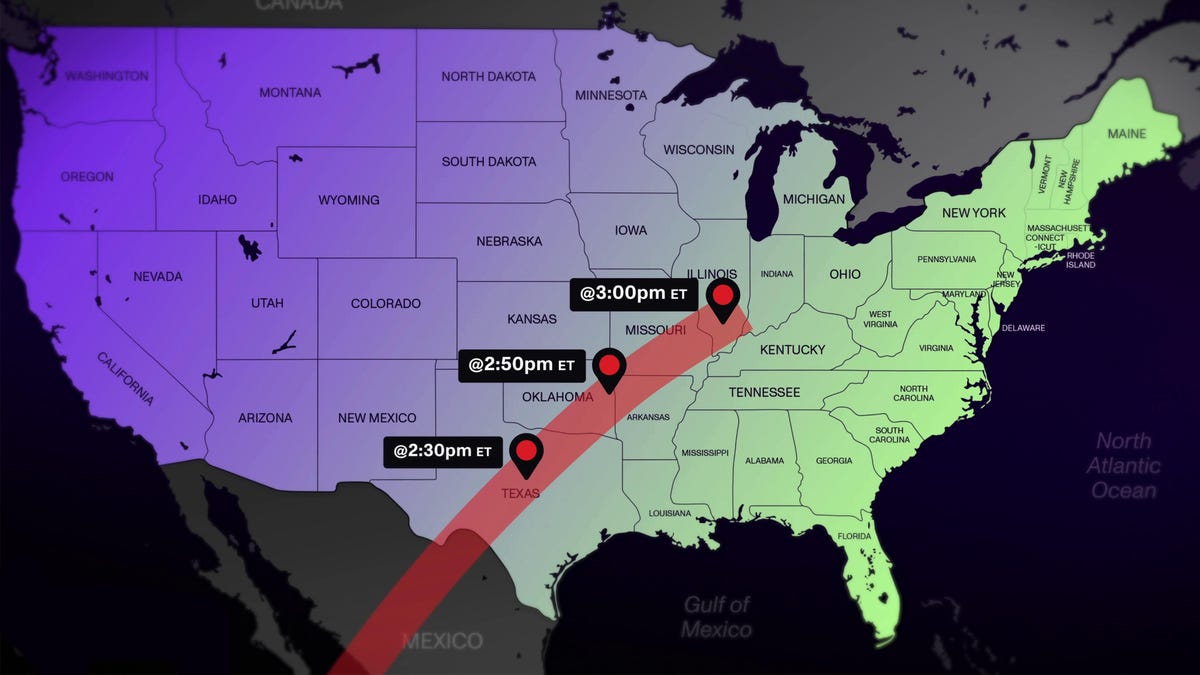NASA Leans Into Solar Eclipse With 3 Rocket Launches: Here's What's Up With That
The space agency isn't letting today's solar eclipse go to waste.

We're just hours away from North America's last total solar eclipse until 2044, and as we prepare to look to the sky, NASA is preparing to launch three rockets.
Before, during and after the eclipse on Monday, NASA will fire three sounding rockets to determine how the total eclipse could affect radio communications on Earth. The findings could pave the way for NASA to develop new technologies to protect radio communications during both brief and extended periods when solar behavior disrupts particles on Earth.
Stargazers from Mexico to the US and Canada are standing by for the last total solar eclipse to pass over the contiguous US for the next 20 years. The duration of totality, or the time during which the moon completely shrouds the sun from view, will last 4 minutes and 27 seconds. The eclipse will reach Texas at approximately 1:10 p.m. ET and Maine by 2:22 p.m. ET. By 4:17 p.m. ET, it will move beyond the eastern North American border.
Firing rockets during an eclipse may sound like it comes straight from a sci-fi movie, but it's a technique that's been used for years to measure scientific data and theories. Indeed, eclipses provide critical, if short-lived, opportunities for scientists to gather information on a variety of topic areas to test whether their concepts are accurate.
Arguably the most important finding during an eclipse occurred in May 1919, when scientists discovered during a total eclipse that some stars appeared to be in the wrong place, according to NASA. The finding provided critical evidence to support Albert Einstein's theory of relativity and the idea that the sun or other large celestial objects have so much gravity that they can bend light and distort spacetime.
NASA's rocket launches on Monday won't necessarily have that same gravitas, but science works in increments. The launches will be streamed live, so you can see what happens. Here's how.
Why is NASA firing rockets during the eclipse?
The space agency is firing three sounding rockets, or rockets carrying scientific instruments, into the ionosphere, the region of the Earth's atmosphere between the lower atmosphere, where we live, and space.
The ionosphere is scientifically important because it's made up of particles that become ionized, or electrically charged, when they interact with the sun's radiation. According to NASA, the ionosphere thins at night and thickens when the sun's rays are hitting it. The ionosphere can be unpredictable, since it's highly sensitive to disruption.
"Earth's terrestrial weather and space weather can impact these particles, making it a dynamic region and difficult to know what the ionosphere will be like at a given time," NASA says.
Another thing: the ionosphere affects communication, and especially high-frequency communication like radio waves. That could, for instance, create disturbances in communications with pilots in the air or with government agencies doing research. But radio waves traveling to and from satellites aren't just of concern to aviators and scientists. They're also vital elements of daily life, from satellite internet services like SpaceX's Starlink to the GPS signals that underlie all manner of financial transactions and that help you get where you're going.
From a site in Virginia, NASA's three rockets will be launched into the ionosphere 45 minutes apart: before the eclipse starts; when the eclipse is ongoing; and after the eclipse has reached its peak. The rockets will reach a maximum altitude of 260 miles, allowing them to spend plenty of time in the ionosphere, which spans 55 miles to 310 miles above the Earth's surface.
Each of the rockets is carrying four two-liter soda bottle-sized instruments that will be ejected during flight to evaluate any ionosphere disturbances, or perturbations, during the eclipse.
"Gathering the data on these perturbations will help scientists validate and improve current models that help predict potential disturbances to our communications, especially high frequency communication," NASA says.
Has NASA fired rockets at an eclipse before?
This isn't the first time NASA has fired rockets during an eclipse. In October, NASA fired the same three rockets from its White Sands Test Facility in North Mexico during an annular solar eclipse. The agency said that it was able to recover the rockets and refurbish them, allowing them to be used in Monday's mission.
Thanks to that mission, scientists were able to see ionosphere disturbances after it fired the second and third rockets, during and after the eclipse, respectively. NASA didn't see any ionosphere disturbance during the first launch.
However, this time around, the rockets are equipped with additional instruments, allowing them to capture more information than they did last year, NASA says.
When is NASA firing its rockets?
NASA plans to launch all three rockets from its Wallops Island facility in Virginia. The first rocket will launch at approximately 2:40 p.m. ET, with the second rocket launching at approximately 3:25 p.m. ET. NASA plans to launch the final rocket by 4:05 p.m. ET.
As always, timing on the launches depends on a variety of factors, including on-the-ground conditions, and may be subject to change. But since the eclipse isn't waiting for NASA to be ready to fire rockets, expect the space agency to try to keep a tight schedule to ensure it doesn't miss its window to capture data.
How can I watch NASA fire rockets at the eclipse?
If you're interested in watching NASA's rocket-firing mission, the agency will livestream it from its official Wallops Island YouTube page. It'll also be featured during NASA's official solar eclipse broadcast
The rocket-only livestream will begin at 2:30 p.m. ET. NASA will start airing its solar eclipse coverage at 1 p.m. ET.

